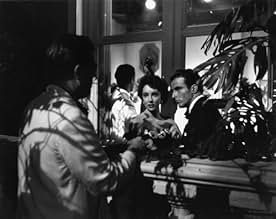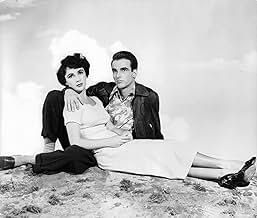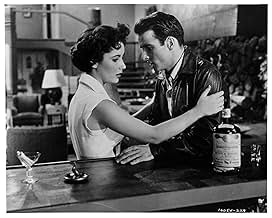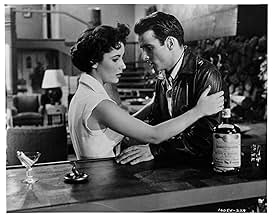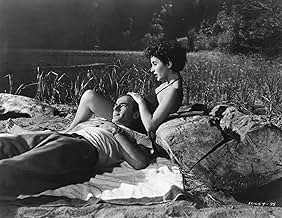A poor boy gets a job working for his rich uncle and ends up falling in love with two women.A poor boy gets a job working for his rich uncle and ends up falling in love with two women.A poor boy gets a job working for his rich uncle and ends up falling in love with two women.
- Won 6 Oscars
- 18 wins & 12 nominations total
Robert J. Anderson
- Eagle Scout
- (uncredited)
Gertrude Astor
- Bit Part
- (uncredited)
Featured reviews
This 1950s melodrama was an interesting, involving story. It's part film-noir, too, which I liked. I say that because the last third of the film featured an expectation of some dreaded act about to be committed, giving it a film noir feel.
One thing for sure, whatever you label the movie: it's well-acted, well-directed and well-photographed. Regarding the latter, this really looks good on DVD. No surprise it's directed well since George Stevens was the director. His resume speaks for itself.
Obviously Montgomery Clift and Elizabeth Taylor are the "big names" in this film, but I found Shelly Winters and the character she played to be the most intriguing. She wasn't really appealing yet one could certainly identify with her feelings of insecurity with Taylor as her competition. "Liz" was in in her prime, looks-wise, with an absolutely classic face.
Anyway, watching the character studies of the antsy Winters and the troublesome Clift were interesting. Clift, as is the case with most of us, causes his own problems and things slowly unravel for him. The story is another example of what can happen when one tries to cover up the truth. It comes back to bite you, big-time!
I really found it refreshing, however, to see Clift's attitude at the end. It's the exact opposite of what you hear today. He actually takes responsibility for his actions.
One thing for sure, whatever you label the movie: it's well-acted, well-directed and well-photographed. Regarding the latter, this really looks good on DVD. No surprise it's directed well since George Stevens was the director. His resume speaks for itself.
Obviously Montgomery Clift and Elizabeth Taylor are the "big names" in this film, but I found Shelly Winters and the character she played to be the most intriguing. She wasn't really appealing yet one could certainly identify with her feelings of insecurity with Taylor as her competition. "Liz" was in in her prime, looks-wise, with an absolutely classic face.
Anyway, watching the character studies of the antsy Winters and the troublesome Clift were interesting. Clift, as is the case with most of us, causes his own problems and things slowly unravel for him. The story is another example of what can happen when one tries to cover up the truth. It comes back to bite you, big-time!
I really found it refreshing, however, to see Clift's attitude at the end. It's the exact opposite of what you hear today. He actually takes responsibility for his actions.
The young and poor George Eastman (Montgomery Clift) leaves his religious mother and Chicago and arrives in California expecting to find a better job in the business of his wealthy uncle Charles Eastman (Herbert Heyes). His cousin Earl Eastman (Keefe Brasselle) advises him that there are many women in the factory and the basic rule is that he must not hang around with any of them.
George meets the worker of the assembly line Alice Tripp (Shelley Winters) in the movie theater and they date. Meanwhile, the outcast George is promoted and he meets the gorgeous Angela Vickers (Elizabeth Taylor) in a party at his uncle's house. Angela introduces him to the local high society and they fall in love with each other. However, Alice is pregnant and she wants to get married with George. During a dinner party at Angela's lake house with parents, relatives and friends, Alice calls George from the bus station and gives thirty minutes to him to meet her; otherwise she will crash the party and tells what has happened. George is pressed by the situation that ends in a tragedy.
"A Place in the Sun" is an unforgettable masterpiece by George Stevens and one of the best love stories ever made, with the perfect development of characters and situations. I watched this film for the first time on 14 June 2001 on cable television and yesterday I saw it again on a Paramount DVD with Extras telling details about the difficulties that George Stevens faced to bring Theodore Dreiser's novel "An American Tragedy" to a motion picture and casting. He had to sue Paramount to carry out the signed contract and get the agreed budget. Another interesting point is Shelley Winters, who was a sex symbol at that time, telling how she got the role of Alice Tripp. Elizabeth Taylor also tells funny things about her relationship with Montgomery Cliff. My vote is ten.
Title (Brazil): "Um Lugar Ao Sol" ("A Place in the Sun")
George meets the worker of the assembly line Alice Tripp (Shelley Winters) in the movie theater and they date. Meanwhile, the outcast George is promoted and he meets the gorgeous Angela Vickers (Elizabeth Taylor) in a party at his uncle's house. Angela introduces him to the local high society and they fall in love with each other. However, Alice is pregnant and she wants to get married with George. During a dinner party at Angela's lake house with parents, relatives and friends, Alice calls George from the bus station and gives thirty minutes to him to meet her; otherwise she will crash the party and tells what has happened. George is pressed by the situation that ends in a tragedy.
"A Place in the Sun" is an unforgettable masterpiece by George Stevens and one of the best love stories ever made, with the perfect development of characters and situations. I watched this film for the first time on 14 June 2001 on cable television and yesterday I saw it again on a Paramount DVD with Extras telling details about the difficulties that George Stevens faced to bring Theodore Dreiser's novel "An American Tragedy" to a motion picture and casting. He had to sue Paramount to carry out the signed contract and get the agreed budget. Another interesting point is Shelley Winters, who was a sex symbol at that time, telling how she got the role of Alice Tripp. Elizabeth Taylor also tells funny things about her relationship with Montgomery Cliff. My vote is ten.
Title (Brazil): "Um Lugar Ao Sol" ("A Place in the Sun")
I can only say that George Stevens' version of Theodore Dreiser's "An American Tragedy" is not what I envisioned when I read the book. Therefore, I came away disappointed at the screen treatment with Liz Taylor (beautiful but shallow), Montgomery Clift (beautiful but shallow) and poor Shelley Winters looking like a drab little wren. An air of artificiality hangs over every scene, every slow-moving scene, and only increases by the time the story arrives at the courtroom climax where an unrestrained Raymond Burr is allowed to chew the scenery.
This is NOT the great picture everyone always says it is. It's one of those films that dates badly. Evidently, fans of Liz Taylor and Monty Clift are starry-eyed about their favorite actors and refuse to see the weaknesses in the plodding story and the thinly sketched characters. Elizabeth Taylor had much better roles in her future career (Cat On a Hot Tin Roof, Giant) and Montgomery Clift would make an unforgettable Morris Townsend in The Heiress. Their acting here is as self-conscious as the arty camerawork that frames them in huge romantic close-ups.
The novel had much more depth and meaning than this watered down version of the story. Read it and you will wonder what all the fuss was about when "A Place in the Sun" was released. Vastly overrated and noteworthy only for the sincere performance of Shelley Winters and Franz Waxman's interesting background score.
This is NOT the great picture everyone always says it is. It's one of those films that dates badly. Evidently, fans of Liz Taylor and Monty Clift are starry-eyed about their favorite actors and refuse to see the weaknesses in the plodding story and the thinly sketched characters. Elizabeth Taylor had much better roles in her future career (Cat On a Hot Tin Roof, Giant) and Montgomery Clift would make an unforgettable Morris Townsend in The Heiress. Their acting here is as self-conscious as the arty camerawork that frames them in huge romantic close-ups.
The novel had much more depth and meaning than this watered down version of the story. Read it and you will wonder what all the fuss was about when "A Place in the Sun" was released. Vastly overrated and noteworthy only for the sincere performance of Shelley Winters and Franz Waxman's interesting background score.
Poor and uneducated George Eastman (Montgomery Clift) unwittingly sets a trap for himself when he takes an entry-level job at his rich uncle's factory, which has a prohibition on male employees dating female employees. He just can't resist one of the girls in his department, the pitiful and whiny Alice Tripp (wonderfully played by Shelley Winters). Eventually, George gets a promotion and is invited into the upper echelon of his uncle's social world, where he meets wealthy and beautiful Angela Vickers (a breathless Elizabeth Taylor). Naturally, he falls in love with Angela. But a complication with Alice leaves him unable to break off his relationship with her.
That's the setup for this George Stevens-directed film that plays rather like a modern Greek tragedy. Everything about "A Place In The Sun" is high quality: the production design, the lavish Edith Head costumes, the wonderful editing, and that great B&W cinematography with those marvelous close-up shots, and overlapping dissolves that cleverly advance the plot.
All three principal actors do a splendid job. And they get solid support from a top notch secondary cast that includes Raymond Burr and the interesting Anne Revere.
The story clearly plays up social class differences, with the haughty rich looking down their noses at common workers. The film's tone varies from romantic, to sad, to suspenseful. At mysterious Loon Lake where significant events occur, the cinematic atmosphere is heavy with anticipation. It's like something out of a Hitchcock thriller.
I've never cared much for sad love stories, and the film does seem a tad dated. Still, it's so well made it can be appreciated by most everyone but the terminally shallow. It has a powerful ending, one that accentuates the acting accomplishments of Clift and especially of Taylor. "A Place In The Sun" was nominated for nine academy awards, and winner of six. I'd say this is one time when Oscar voters got it right.
That's the setup for this George Stevens-directed film that plays rather like a modern Greek tragedy. Everything about "A Place In The Sun" is high quality: the production design, the lavish Edith Head costumes, the wonderful editing, and that great B&W cinematography with those marvelous close-up shots, and overlapping dissolves that cleverly advance the plot.
All three principal actors do a splendid job. And they get solid support from a top notch secondary cast that includes Raymond Burr and the interesting Anne Revere.
The story clearly plays up social class differences, with the haughty rich looking down their noses at common workers. The film's tone varies from romantic, to sad, to suspenseful. At mysterious Loon Lake where significant events occur, the cinematic atmosphere is heavy with anticipation. It's like something out of a Hitchcock thriller.
I've never cared much for sad love stories, and the film does seem a tad dated. Still, it's so well made it can be appreciated by most everyone but the terminally shallow. It has a powerful ending, one that accentuates the acting accomplishments of Clift and especially of Taylor. "A Place In The Sun" was nominated for nine academy awards, and winner of six. I'd say this is one time when Oscar voters got it right.
10bmacv
Bringing Theodore Dreiser's sprawling novel An American Tragedy to the screen must have been a daunting task, made harder by the constraints Paramount imposed on director George Stevens. The studio had lost big on a version made 20 years earlier, under Josef von Sternberg, and had little faith in a remake. So, hobbled by a tight budget, Stevens scaled back his ambitious plans but delivered, perhaps even to his own surprise, a superbly crafted and and powerfully sustained work of movie art.
He was lucky that Paramount, edgy about the story, gave him a cast that would guarantee not only good box office but solid performances as well. Montgomery Clift, Elizabeth Taylor and Shelly Winters take the principal roles, with, in the last third of the movie, extra oomph courtesy of Raymond Burr (in a role that may have nabbed him the Perry Mason franchise).
The jaws of the vise Clift finds himself squeezed into are class and sex. Barely educated, raised by stern members of a religious sect, he luckily (or not) happens to be the shirt-tail nephew of a prosperous entrepreneur who casually offers him work in his factory. Awkward and lonesome, Clift escapes the drudgery of his job by taking up with a mousy co-worker (Winters, toned way down from her platinum-bombshell image at the time). But his nose-to-the-grindstone ways attract the attention of his uncle, who rewards him with a promotion and an invitation up to the manor.
There he meets Taylor and launches an obsession about her, reinforced by a neon sign visible from his window that blazes her surname through his restless nights (she's another child of an industrial fortune, raised in wealth and privilege). Somehow, she falls for him and, need it be added, he for her despite his coming from the wrong side of the tracks (she hasn't the faintest notion that for people like him, life may not be the blithe affair it is for her).
Only one inconvenient fact keeps Clift from taking his rightful place in the sun: He's left Winters pregnant. The two worlds he occupies are destined to collide, and crash they do when Winters phones him, in the midst of a Hawaiian-themed luau at Taylor's summer place on the lake, to issue her ultimatum: Marry her or she'll spill their sordid secret. He leaves abruptly to meet Winters, desperately trying to assemble the plan which will seal three fates.
Stevens sustains an overwhelming, ominous momentum, unbroken by even a hint of levity (not even a single bit player is allowed to lapse into shtik). Languorous dissolves and superimposed images heighten the sense of inevitability as each scene, each event glides seamlessly into the next.
Maybe he wasn't able to pile on the exhaustive social commentary that bulked up Dreiser's novel, but everywhere there's sharp detail that he adroitly leaves to be noticed. When Clift shows up hours late at his intimate birthday party in Winter's cramped room, with the tiny table pushed up against her marble washstand, the ice cream has warmed to lumpy syrup (a self-homage to a similar scene in Steven's Alice Adams?). With an island combo playing merrily on, Clift sports a lei and eats pineapple out of its shell when Winters calls to break the spell and this South-Seas reverie is offered up not as Veblenesque excess, but merely as the way Taylor's crowd spend their days and evenings and nights in an endless round of heedless gaiety.
The apex of the film's crescendo is handled with tight, quiet assurance the reckoning in a rowboat upon a deserted lake. Dusk gathers among the pines like fog, the loons call back and forth, and the rippling waves reflect a demented flash into Clift's eye as he wrestles with his conscience. Winters natters nervously about the dreary life they'll spend together while his head swims with luminous visions of Taylor. Then, destiny catches.... Romantic but unsentimental, serious but without pretension, gripping without stooping to the manipulative, A Place in the Sun ranks as a masterpiece of American cinema.
He was lucky that Paramount, edgy about the story, gave him a cast that would guarantee not only good box office but solid performances as well. Montgomery Clift, Elizabeth Taylor and Shelly Winters take the principal roles, with, in the last third of the movie, extra oomph courtesy of Raymond Burr (in a role that may have nabbed him the Perry Mason franchise).
The jaws of the vise Clift finds himself squeezed into are class and sex. Barely educated, raised by stern members of a religious sect, he luckily (or not) happens to be the shirt-tail nephew of a prosperous entrepreneur who casually offers him work in his factory. Awkward and lonesome, Clift escapes the drudgery of his job by taking up with a mousy co-worker (Winters, toned way down from her platinum-bombshell image at the time). But his nose-to-the-grindstone ways attract the attention of his uncle, who rewards him with a promotion and an invitation up to the manor.
There he meets Taylor and launches an obsession about her, reinforced by a neon sign visible from his window that blazes her surname through his restless nights (she's another child of an industrial fortune, raised in wealth and privilege). Somehow, she falls for him and, need it be added, he for her despite his coming from the wrong side of the tracks (she hasn't the faintest notion that for people like him, life may not be the blithe affair it is for her).
Only one inconvenient fact keeps Clift from taking his rightful place in the sun: He's left Winters pregnant. The two worlds he occupies are destined to collide, and crash they do when Winters phones him, in the midst of a Hawaiian-themed luau at Taylor's summer place on the lake, to issue her ultimatum: Marry her or she'll spill their sordid secret. He leaves abruptly to meet Winters, desperately trying to assemble the plan which will seal three fates.
Stevens sustains an overwhelming, ominous momentum, unbroken by even a hint of levity (not even a single bit player is allowed to lapse into shtik). Languorous dissolves and superimposed images heighten the sense of inevitability as each scene, each event glides seamlessly into the next.
Maybe he wasn't able to pile on the exhaustive social commentary that bulked up Dreiser's novel, but everywhere there's sharp detail that he adroitly leaves to be noticed. When Clift shows up hours late at his intimate birthday party in Winter's cramped room, with the tiny table pushed up against her marble washstand, the ice cream has warmed to lumpy syrup (a self-homage to a similar scene in Steven's Alice Adams?). With an island combo playing merrily on, Clift sports a lei and eats pineapple out of its shell when Winters calls to break the spell and this South-Seas reverie is offered up not as Veblenesque excess, but merely as the way Taylor's crowd spend their days and evenings and nights in an endless round of heedless gaiety.
The apex of the film's crescendo is handled with tight, quiet assurance the reckoning in a rowboat upon a deserted lake. Dusk gathers among the pines like fog, the loons call back and forth, and the rippling waves reflect a demented flash into Clift's eye as he wrestles with his conscience. Winters natters nervously about the dreary life they'll spend together while his head swims with luminous visions of Taylor. Then, destiny catches.... Romantic but unsentimental, serious but without pretension, gripping without stooping to the manipulative, A Place in the Sun ranks as a masterpiece of American cinema.
Did you know
- TriviaIn her autobiography, Shelley Winters described producer and director George Stevens' way of working: "He would discuss the scene, but not the lines, and would photograph the second or third rehearsal so the scene had an almost improvisatory quality. Stevens would print the first take, then spend the next three hours minutely rehearsing the scene, then film it again. He explained to me that in this way he often got actors' unplanned reactions that were spontaneous and human and often exactly right. And often when actors overintellectualize or plan their reactions, they aren't as good."
- GoofsAlice Tripp is wearing different shoes when she starts walking home from the movie with George Eastman from those she is wearing when they near her residence. When Shelley Winters pointed out to director George Stevens that the brown and white shoes she was wearing turned to black when she walked around the corner, the director refused to re-shoot the scene. According to Winters, he said, "If they're looking at her feet, I can go home."
- ConnectionsFeatured in Hollywood: The Fabulous Era (1962)
Details
Box office
- Budget
- $2,295,304 (estimated)
- Gross worldwide
- $18,247
- Runtime2 hours 2 minutes
- Color
- Aspect ratio
- 1.37 : 1
Contribute to this page
Suggest an edit or add missing content




